The Economics and Statistics Division maintains archives of previous publications for accountability purposes, but makes no updates to keep these documents current with the latest data revisions from Statistics Canada. As a result, information in older documents may not be accurate. Please exercise caution when referring to older documents. For the latest information and historical data, please contact the individual listed to the right.
<--- Return to Archive
For additional information relating to this article, please contact:
March 12, 2021LABOUR MARKET TRENDS - FEBRUARY 2021 LABOUR MARKET TRENDS - FEBRUARY 2021
Labour force survey results reflect the period from February 14 to 20, during which time public health measures that had been in place since December were eased in many provinces. There was re-opening of non-essential businesses, cultural and recreational facilities, and some in-person dining. Restrictions were eased on February 8 in Quebec, Alberta, New Brunswick and Nova Scotia. Manitoba eased a variety of measures on February 12. In mid-February, several Ontario regions had restrictions lifted while Newfoundland and Labrador reintroduced lockdown public health measures.
Nova Scotia’s seasonally adjusted employment level was up 2,500 (+0.5%) to 465,200 in February 2021.
Nova Scotia’s employment is only 1,800 (-0.4%) lower than the pre-COVID level of February 2020, the closest among the provinces to returning to this benchmark. Nova Scotia has recovered nearly 98% (73,200) of the peak employment loss reported in April (75,000). In comparison, Canada has recovered 80% (2.390 million) of April peak employment losses (-2.989 million).
Nova Scotia’s labour force increased 1,400 (+0.3%) to 506,200 in February. The labour force in February 2021 is smaller by 1,400 (-0.3%) than February 2020 despite population growth of 5,600 (+0.7%) since then. The number of unemployed persons decreased 1,100 compared to January and is 400 higher compared to February 2020.
With a proportionally larger increase in employment and a labour force, the unemployment rate decreased 0.2 percentage points from last month to 8.1% in February 2021.
The population not in the labour force decreased 1,200 compared to last month. Compared to February 2020, there are an additional 7,000 persons not in the labour force.
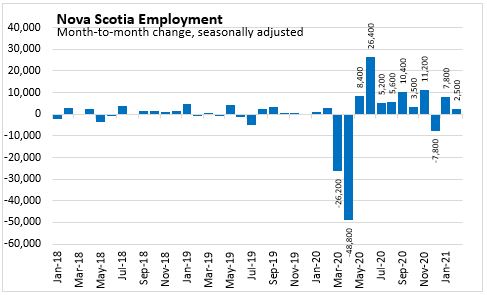
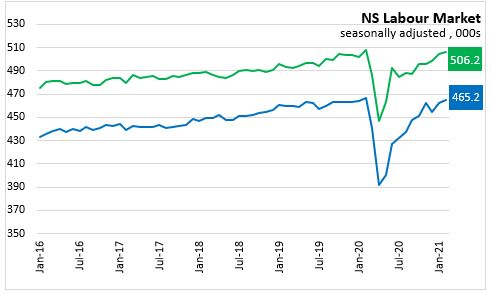
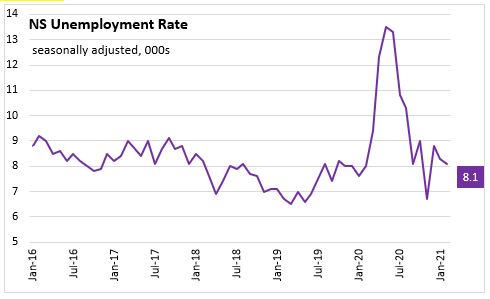
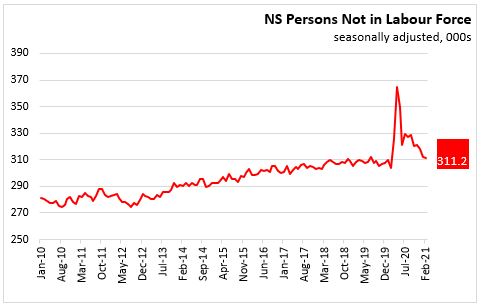
In February, full-time employment decreased 1,200 (-0.3%) while part-time employment increased 3,600 (+4.4%). Employment since February 2020 has increased by 3,800 (+1.0%) in full-time jobs but is lower by 5,600 (-6.2%) in part-time jobs. Changes in the number of hours worked within one job can result in shift employment between part-time and full-time.
The participation rate was up 0.1 percentage points to 61.9% in February and remains 0.6 percentage points below the level observed in February 2020. The employment rate increased 0.3 percentage points to 56.9% and is down 0.6 percentage points compared to the February 2020 level.

In addition to the employment decline form February 2020, there are elevated numbers of persons who are counted as employed, but have zero hours (for non-routine reasons like vacation, maternity/parental leave, labour dispute) or had their hours cut by 50% or more. In February 2021 in Nova Scotia there were 24,100 persons employed but at less than 50% of their usual hours (including zero hours), down from 27,300 in January 2021 and still elevated by 4,300 compared to 19,800 in February 2020. Combined with those who have lost employment, this amounts to about 1.3% of Nova Scotia’s February 2020 employment level; down from a high of 28.1% in April 2020. The largest total employment/hour impact in January 2021 was Newfoundland and Labrador (12.7%) and the smallest was in Nova Scotia (1.3%) followed by British Columbia (1.9%).

Statistics Canada reported in supplemental information that Nova Scotia had an increase of 1,400 (Jan-21 to Feb-21) of people who were not in the labour force but wanted to work, currently at 16,500 people. This is down from the 55,600 people in April 2020.
The labour underutilization rate (COVID-19 impact definition) is the proportion of the potential labour force (labour force + those wanting work) that is either unemployed, not in labour force but wanted work or employed but have lost the majority of their usual hours.
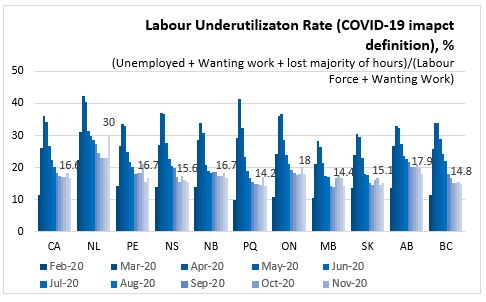
Labour underutilization has declined from highs during March and April but remains elevated compared to February 2020 in all provinces. In February 2020, Nova Scotia's labour underutilization rate was 14.1%. This underutilization increased to 37.1% in April 2020 and subsequently fell 15.6% in November 2020 before rising in December to 17.3% and subsequently declining to 15.6% in February 2021. The February 2021 highest labour underutilization rate is in Newfoundland and Labrador (30.0%) and the lowest is in Quebec (14.2%).
Age Cohorts
Comparing February 2021 to February 2020, the remaining shortfall in employment is mostly attributable to declines in the youth cohort (ages 15-24). Employment among youth was down 5,400 from February 2020 to February 2021 while the labour force declined by 7,000. For core-aged workers (25-54), employment was up from February 2020 to February 2021 (+600) with the labour force down slightly (-100) over the last year. For older workers, employment increased 3,000 from February 2020 while the labour force was up 5,800.
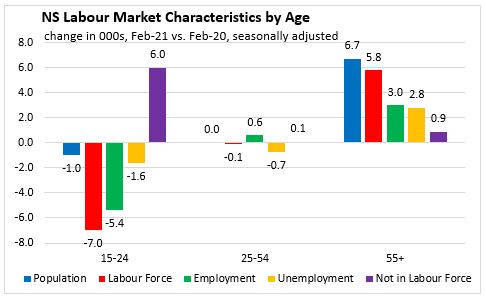
The unemployment rate increased for core-aged and older workers in Nova Scotia in February 2021. Compared to the previous month, unemployment rate decreased 4.9 percentage points to 12.5% for youth workers (ages 15-24). For core-aged workers (ages 25-54) and older workers (ages 55 and over), unemployment rate increased 0.6 percentage points to 6.8% and 8.8% respectively.
The participation rate for younger Nova Scotians decreased 2.8 percentage points to 67.2% in February 2021. For core-aged workers, the participation rate was unchanged at 88.0% while the participation rate for older workers rose 1.2 percentage points to 34.5% in January.
Compared to January 2021, employment rates increased for younger and older age groups. Employment rate for youth increased 0.9 percentage points to 58.7% and 1.0 percentage points to 31.5% for older workers. For core-age workers, the employment rate declined 0.6 percentage points to 82.0%.
Compared with February 2020, employment rates are down for youth (-4.4 percentage points) but higher fore core-aged (+0.1 percentage points) and older workers (+0.3 percentage points).
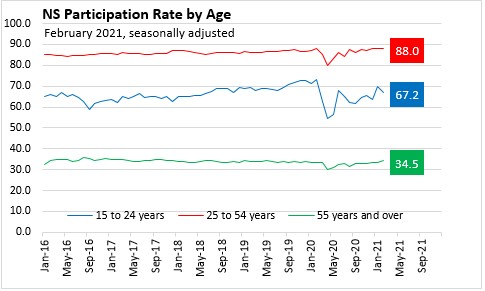
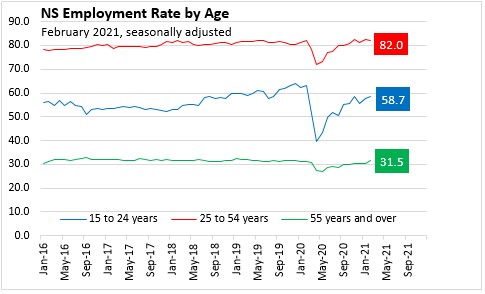
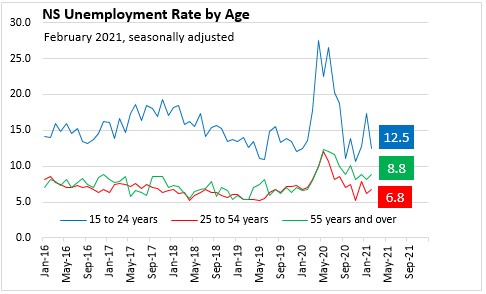
Note: this article originally contained charts for participation, employment and unemployment rates by age cohort that did not display the line for the latest data point. These charts have been updated to show February 2021 results
Males and Females
Compared with February 2020, female employment was 1,400 (+0.6%) above its pre-pandemic level while male employment remained 3,200 (-1.4%) below the pre-pandemic level. Compared to February 2020, the male labour force was down 1,400 (-0.5%) and the female labour force has increased by 100 (+0.04%)The number of unemployed males has increased 1,700 and the number of unemployed females was down 1,300. The male population not in the labour force increased by 4,200 from February 2020 to February 2021 while the number of females not in the labour force grew by 2,800.
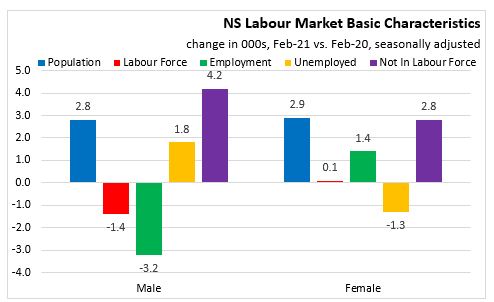
In February 2021, the monthly unemployment rate declined 0.4 percentage points to 9.7% for males and remained unchanged at 6.5% for females.
The participation rate was up 0.4 percentage points to 59.3% for females and was unchanged at 64.8% for males.
The monthly employment rate was up 0.3 percentage points to 55.4% for females and 0.2 percentage points for males to 58.5%.
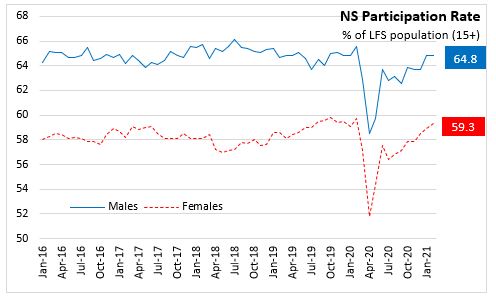
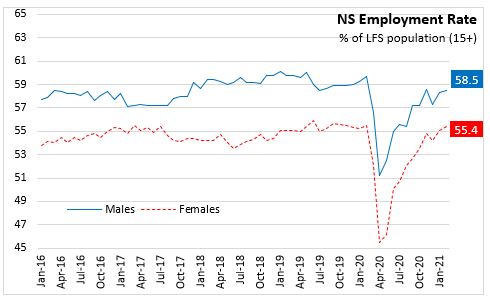

Sectors and Industries
The monthly employment gain from January to February was in private sector employees (+7,500) with smaller offsetting decreases in public sector employees (-4,700) and self-employment (-300). Compared to February 2020, employment remains lower in the private sector (-9,100) and self-employed (-2,400) and is higher in public sector employees (+9,700).
For February, goods-producing sector employment was down 1,100 jobs construction (-1,400) accounting for most of the change.
Service-producing sector employment increased 3,500 in February. Employment gains were largest in accommodation and food service (+5,600), finance, insurance and real estate (+2,200), other services (+1,600, including personal and repair services), as well as in wholesale and retail trade (+1,200). Health care and social assistance (-2,300), educational services (-1,400) and professional, scientific and technical services (-1,200) reported the largest declines this month.
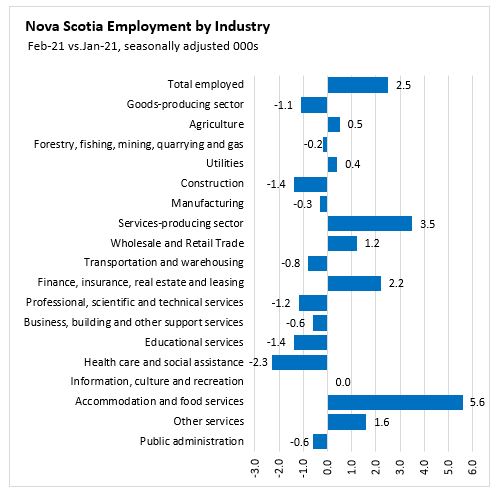
Employment since February 2020 is 2,400 higher in goods-producing industries with higher levels in agriculture, utilities and construction offsetting declines in manufacturing and forestry, fishing, mining, quarrying, oil and gas.
Service-producing employment is lower by 4,200 since February 2020 with the lower levels in wholesale and retail trade (-6,600), accommodation and food service (-7,600), and information, culture and recreation (-3,000) accounting for the largest number of job losses that have not been recovered.
Employment levels in February 2021 are also lower in business, building and other support services (-1,800) and health care and social assistance (-200) than February 2020.
Employment levels are higher in February 2021 than February 2020 in other sectors with the largest increases in professional, scientific, and technical services (+4,800), educational services (+4,100), fire, insurance, real estate and leasing (+2,800), and transportation and warehousing (+2,200).
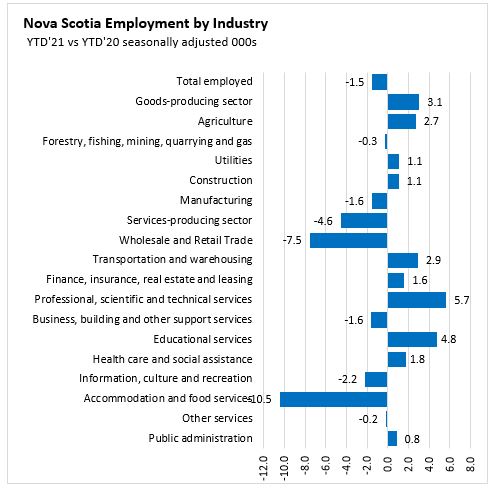

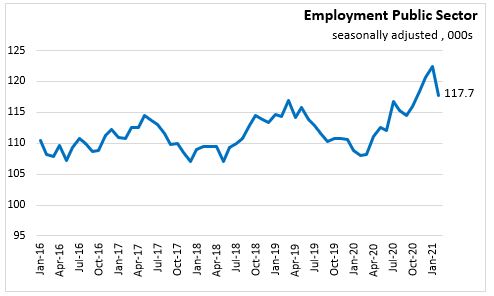
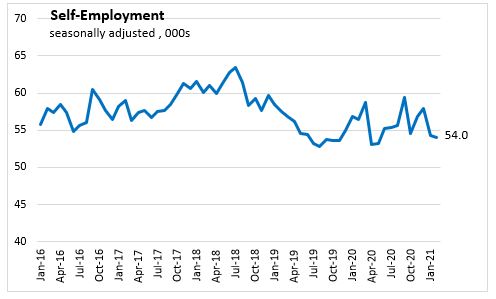
Regions – February 2021 vs February 2020 (unadjusted 3 month moving average)
Compared with February 2020, Cape Breton employment declined by 7,100 while the labour force was down 7,400. The number of unemployed decreased 300 and the unemployment rate increased 1.3 percentage points to 14.2%. There are an additional 6,800 persons not in the labour force in Cape Breton compared to February 2020 data.
For the North Shore region, the labour force declined by 1,500 while employment was down by 500. The number of unemployed declined by 1,000 and the unemployment rate has decreased 1.1 percentage points to 8.3%.
The Annapolis Valley reported little change with a decline of 100 in the labour force and an increase of 100 in employment compared to February 2020 data. The unemployment rate declined 0.4 percentage points to 7.5% and there are an additional 500 persons not in the labour force.
Compared to a year ago, the Southern region experienced a decrease of 500 in labour force and 900 in employment. The number of unemployed increased by 200 and the unemployment rate increased 0.5 percentage points to 8.8%.
In the Halifax region, the labour force recorded an increase of 9,500 while employment has increased 5,200 compared to February 2020. With unemployment increasing 4,300, the unemployment rate increased 1.4 percentage points to 8.1%. The number of persons not in the labour force decreased by 2,500 in Halifax from a year ago.

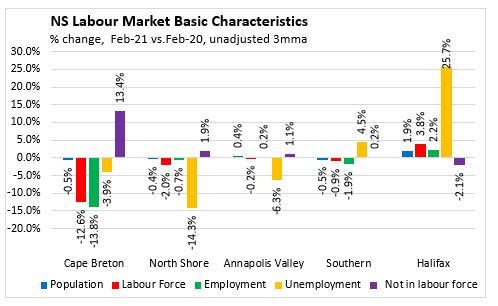

Provincial Comparisons
Seven provinces reported increasing employment in February with declines in Newfoundland and Labrador (-6.8%), Prince Edward Island (-0.6%) and New Brunswick (-0.7%). Quebec (+2.7%) and Manitoba (+2.6%) reporting the largest increases.
Statistics Canada notes that there were increased restrictions on certain economic activities in Newfoundland and Labrador and easing of previous restriction in a number of other provinces including Quebec, Ontario, and Manitoba.
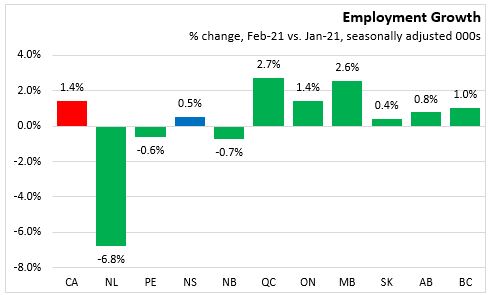
Compared to February 2020, the labour force has increased in New Brunswick (+0.1%) and British Columbia (+1.4%) with all other provinces continuing to report lower levels. The largest decline in the labour force since February 2020 is in Newfoundland and Labrador (-4.5%).
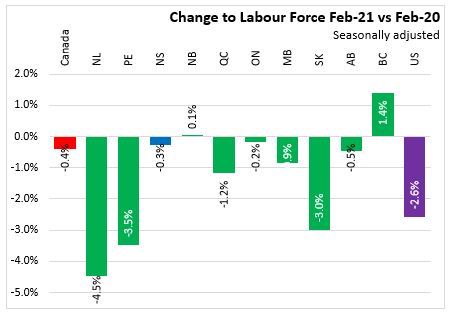
All provinces report lower employment in February 2021 than February 2020. The largest employment declines since February is in Newfoundland and Labrador (-7.6%), Prince Edward Island (-4.8%) and Ontario (-4.1%). The employment change in Nova Scotia (-0.4%) is the smallest decline over the past year among the provinces. Statistics Canada noted that employment change over the last year in Nova Scotia and British Columbia are not statistically significant.
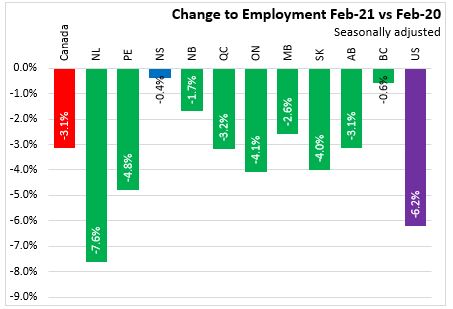
Unemployment rates were up in four provinces in February 2021 – Newfoundland and Labrador, Prince Edward Island, New Brunswick, and Saskatchewan. The highest unemployment rate for February 2021 is in Newfoundland and Labrador at 15.3% and the lowest is in Quebec at 6.4%. Canada’s unemployment rate was 8.2% in February 2021.
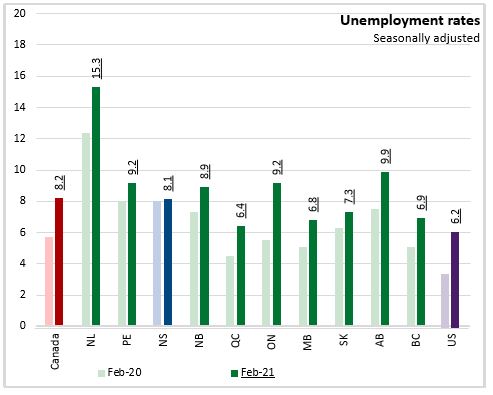
National Comparisons: Cities (Monthly, 3 month moving average)
The unemployment rate for Halifax Census Metropolitan Area (CMA) in February 2021 was 8.1% (seasonally adjusted 3 month moving average). Victoria at 4.9% had the lowest unemployment rate among CMAs while the highest was in Barrie (13.0%).

The seasonally adjusted employment rate for Halifax was 63.7%, up compared to last month and the second highest among CMAs this month. Calgary (64.0%) had the highest employment rate while St. Catharines-Niagara (48.9%) had the lowest among CMAs.
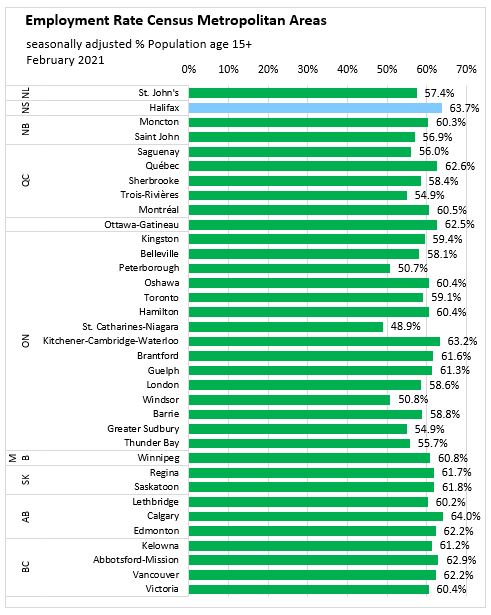
Halifax’s employment (3 month moving average) for February 2021 was up 0.6 % compared to the January 2021 result. The employment level (Dec-Feb) average compared to previous average (Nov-Jan) was up by the largest amount in Peterborough (+3.8%) and decreased the most in St. John’s (-3.3%).
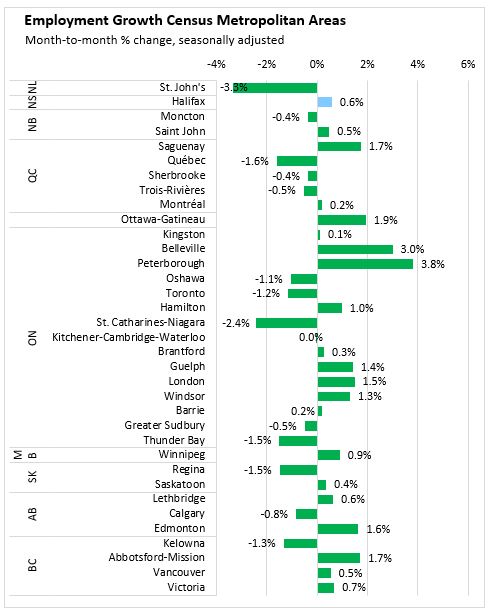
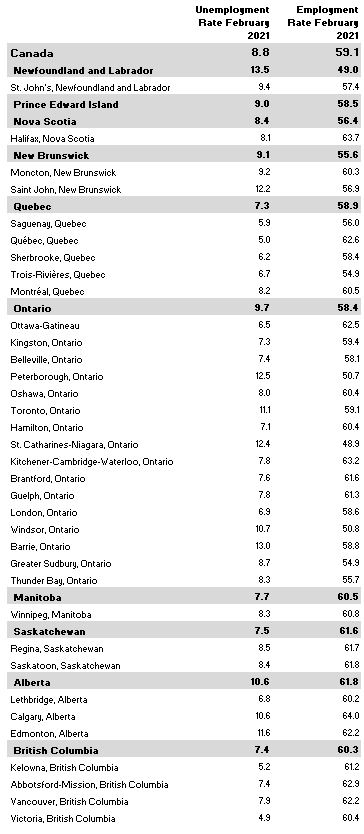
Note: Seasonally adjusted, 3 month average.
Sources:
Statistics Canada. Table 14-10-0287-01 Labour force characteristics, monthly, seasonally adjusted and trend-cycle, last 5 months
Statistics Canada. Table 14-10-0294-01 Labour force characteristics by census metropolitan area, three-month moving average, seasonally adjusted and unadjusted, last 5 months
Statistics Canada. Table 14-10-0293-01 Labour force characteristics by economic region, three-month moving average, unadjusted for seasonality, last 5 months
Statistics Canada. Table 14-10-0355-01 Employment by industry, monthly, seasonally adjusted and unadjusted, and trend-cycle, last 5 months (x 1,000)
Statistics Canada. Table 14-10-0288-01 Employment by class of worker, monthly, seasonally adjusted and unadjusted, last 5 months (x 1,000)
<--- Return to Archive